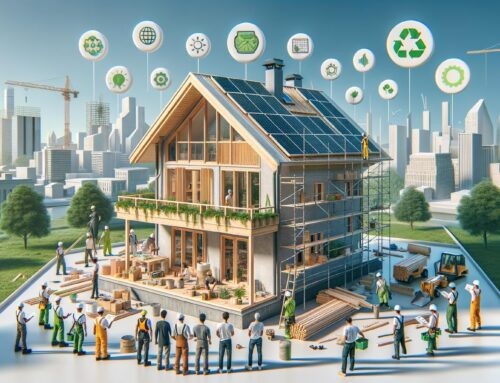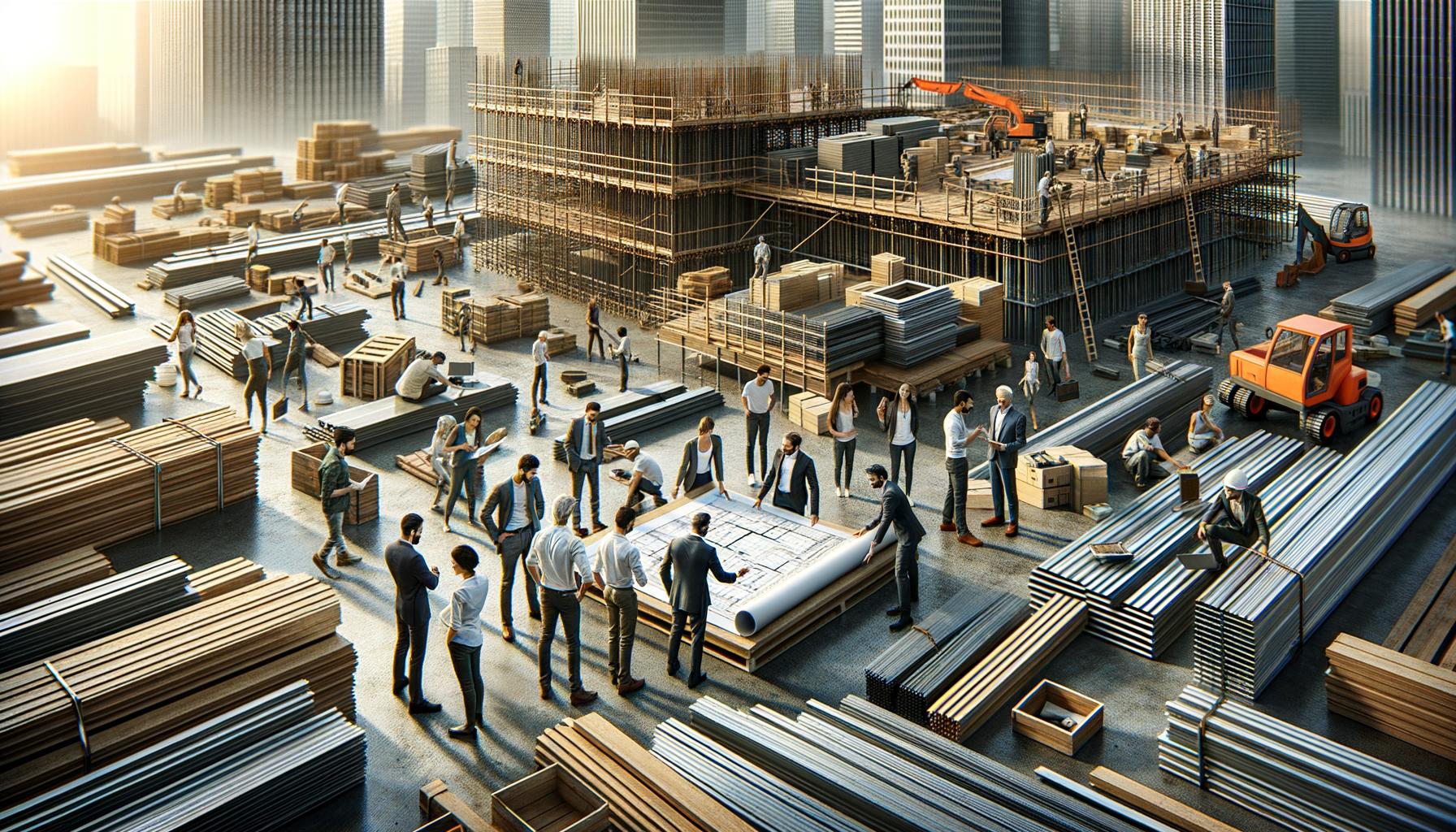
Selecting the right material building materials for your construction project can be a daunting task. With countless options available, it’s essential to consider factors like cost, durability, and environmental impact.
At Home Owners Association, we understand the importance of making informed decisions when it comes to your building projects. This guide will help you navigate the world of construction materials and choose the best options for your specific needs.
What Factors Matter Most When Choosing Building Materials?
The Budget Balancing Act
Cost often tops the list of concerns for builders. However, looking beyond the initial price tag is essential. Cheaper materials might tempt you at first, but they can result in higher maintenance costs later. For example, when choosing flooring, consider factors like foot traffic, maintenance requirements, and installation costs.
A 2024 construction industry report reveals that material costs constitute 50-60% of total building expenses. This fact highlights the importance of strategic material selection to optimize your budget without sacrificing quality.
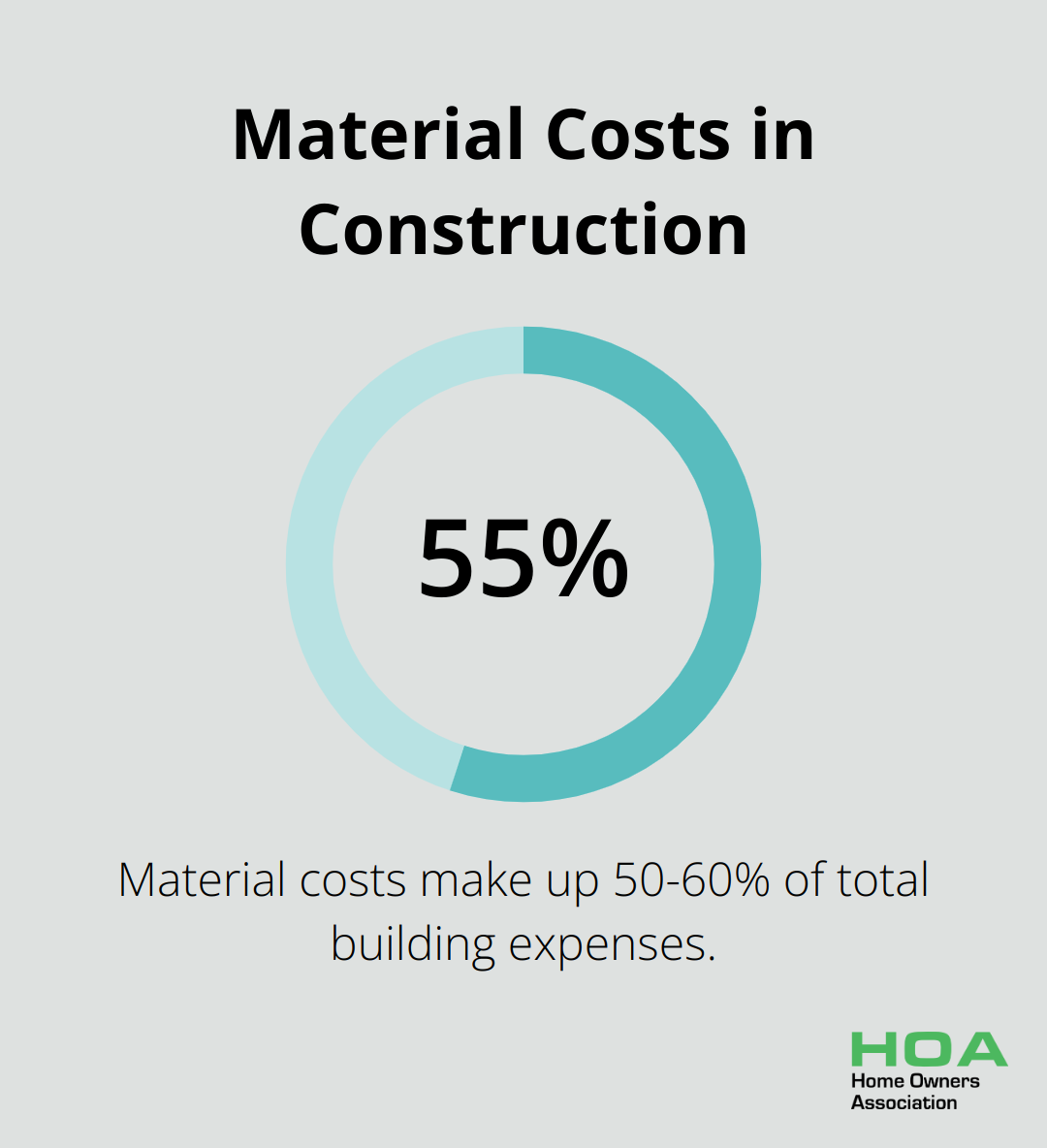
Durability: The Long Game
The longevity of your chosen materials directly impacts your project’s overall value. In Australia’s diverse climate (from tropical north to temperate south), materials must withstand various environmental challenges.
In coastal areas, salt-resistant materials like stainless steel and certain types of treated timber are essential. Inland, where temperature fluctuations are more extreme, materials with good thermal properties (such as brick or stone) can contribute to energy efficiency and structural integrity.
Sustainability: More Than Just a Buzzword
Environmental considerations continue to gain importance in construction. Sustainable building practices can significantly reduce a structure’s carbon footprint, with a potential 23% reduction in upfront carbon emissions from public infrastructure equivalent to a reduction of 9 Mt CO₂e, roughly 2% of Australia’s emissions.
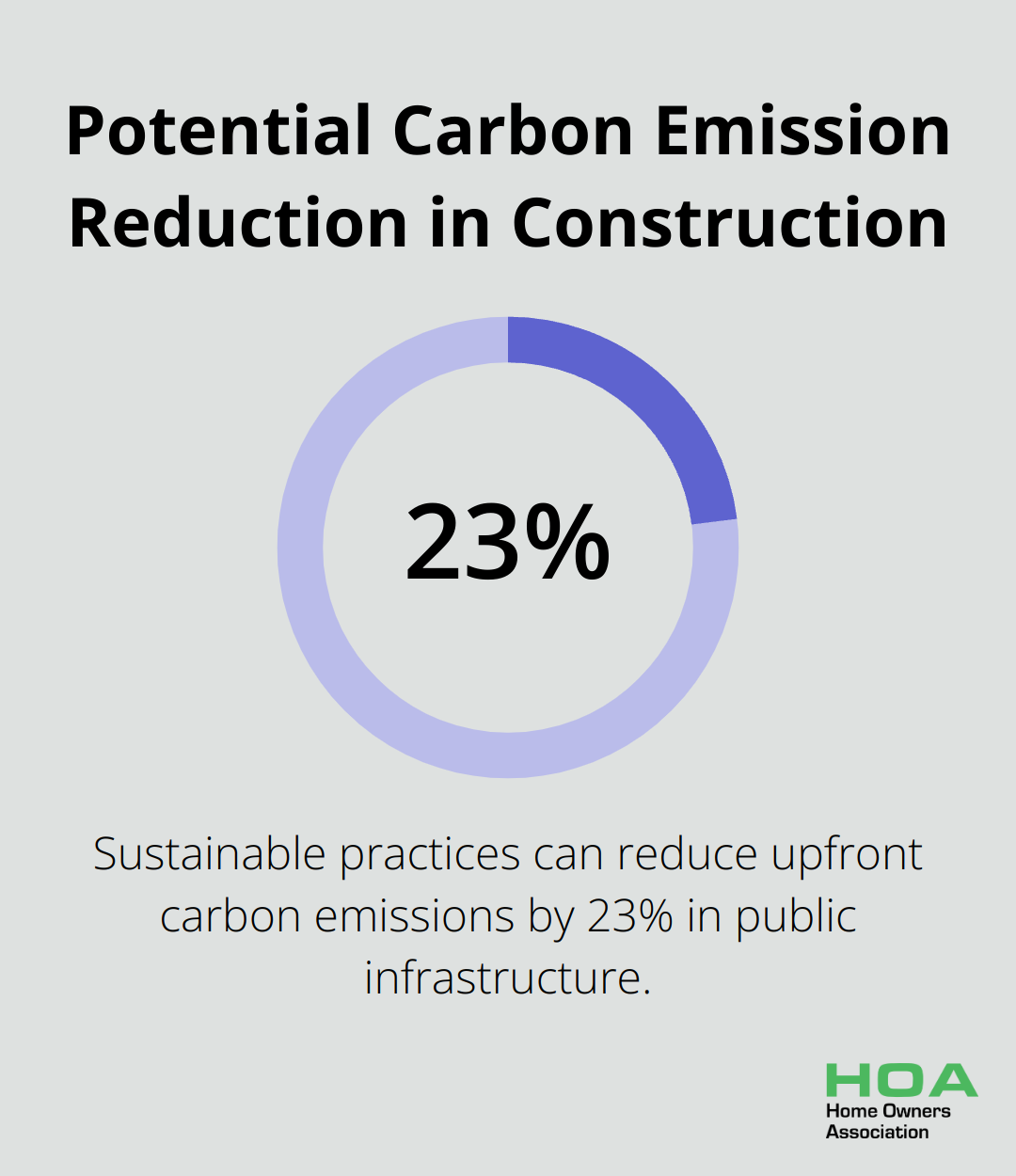
Recycled steel exemplifies a sustainable choice. It outperforms plastic, paper, aluminum, and glass combined as the most recycled material. Every tonne of recycled steel saves about 1,115 kg of iron ore, 625 kg of coal, and 53 kg of limestone. Plus, it maintains its properties through infinite recycling cycles.
Local Sourcing: A Smart Strategy
Opting for locally sourced materials supports the Australian economy and can reduce transportation costs and carbon emissions. The Australian government recommends sourcing materials within a 400km radius to minimize environmental impact.
Local sourcing also ensures that materials suit regional conditions well. For instance, certain Australian hardwoods naturally resist termites, making them ideal for areas prone to these pests.
The Aesthetic Factor
While functionality takes precedence, the visual appeal of your building materials shouldn’t fall by the wayside. The right materials can enhance property value and create a lasting impression.
Home design trends in 2025 are being driven by factors such as affordability, size innovation, and changing lifestyles, which are influencing both aesthetics and functionality.
The best material choices strike a balance between all these factors. As we move forward, let’s explore some popular building materials and their unique properties to help you make informed decisions for your next project.
Top Building Materials for Your Project
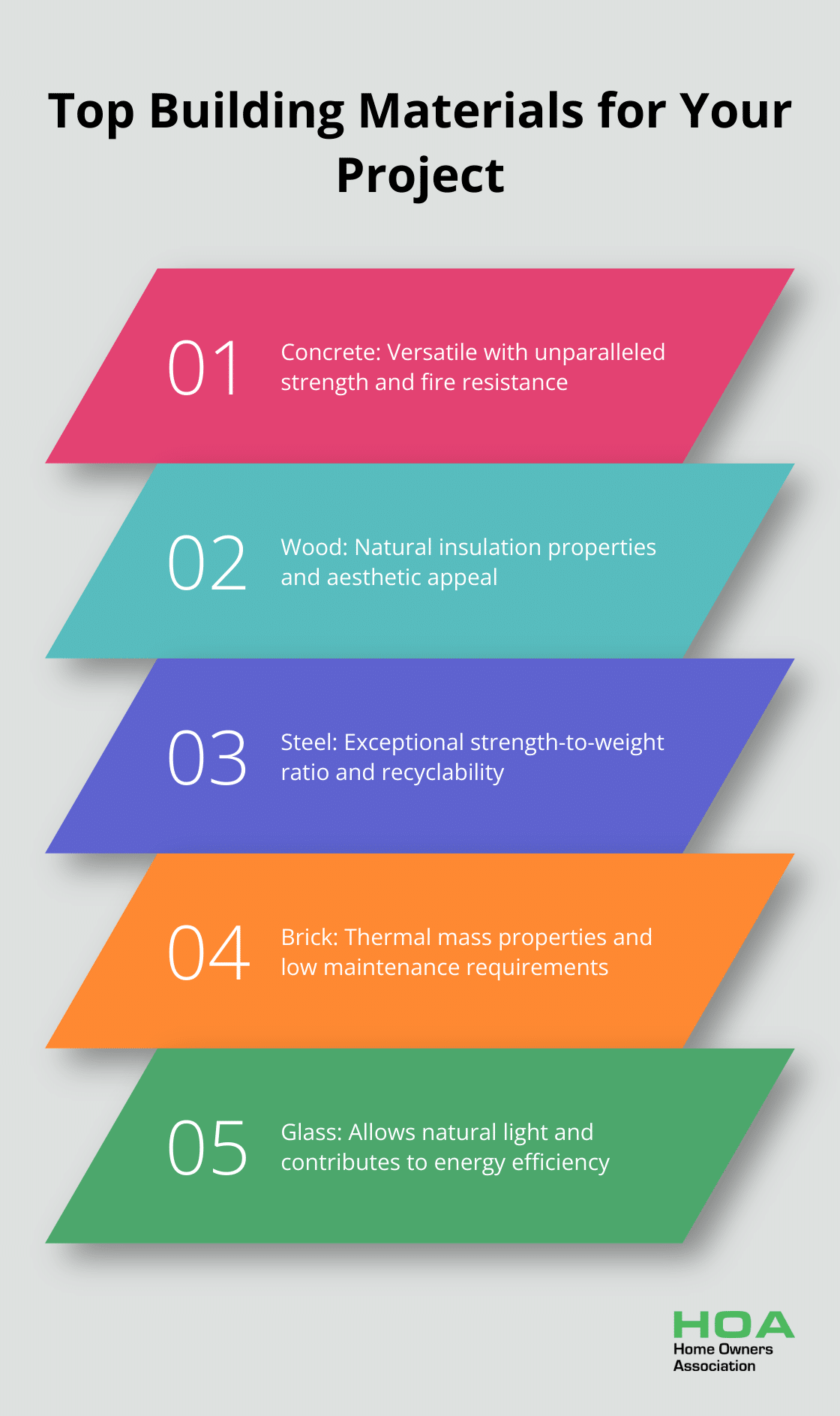
The Versatility of Concrete
Concrete remains a cornerstone of modern construction. Its unparalleled strength and fire resistance make it ideal for foundations, walls, and structural elements. In Australia, where bushfires pose a significant concern, concrete’s fire-resistant properties prove particularly valuable.
Recent advancements have led to the development of high-performance concrete mixes that offer enhanced durability and reduced environmental impact. Geopolymer concretes can significantly reduce the cost and CO2 emissions compared to conventional concrete.
The Natural Appeal of Wood
Wood continues to be a favorite among builders and homeowners alike. Its natural insulation properties can contribute to energy efficiency, potentially reducing heating and cooling costs.
Australian hardwoods like Jarrah are not only beautiful but also naturally resist weather, rot, termites, and even marine borers. These species can last for decades with proper maintenance, making them a sustainable choice for both structural and decorative applications.
The Strength of Steel
Steel’s exceptional strength-to-weight ratio makes it an excellent choice for large-scale projects and areas prone to seismic activity. Its durability and recyclability also contribute to its popularity in sustainable construction.
In Australia, the use of steel framing in residential construction has grown significantly. This trend is partly due to steel’s resistance to termites, a common problem in many parts of the country.
The Timeless Appeal of Brick
Brick remains a popular choice for its thermal mass properties and low maintenance requirements. In Australia’s climate, brick’s ability to regulate indoor temperatures can lead to energy savings compared to lightweight construction materials.
Modern brick manufacturing techniques have also improved sustainability. Some Australian brick manufacturers now use recycled materials in their products, reducing the environmental impact.
The Efficiency of Glass
Glass plays a key role in modern architecture, allowing natural light and contributing to energy efficiency. Advanced glazing technologies, such as low-E coatings and double or triple glazing, can reduce heat loss compared to single-pane windows.
In Australia, where abundant sunlight is both a blessing and a challenge, smart glass technologies are gaining traction. These can automatically adjust their tint based on sunlight intensity, potentially reducing cooling costs.
Selecting the right materials for your project involves balancing various factors. While each material has its strengths, the best choice often depends on your specific needs, local climate, and project goals. As we look to the future of construction, exciting new trends in building materials are emerging that promise to revolutionize the industry.
What Are the Latest Innovations in Building Materials?
The construction industry continues to evolve, with new materials and technologies addressing challenges in sustainability, efficiency, and performance. We’ll explore some of the most promising innovations that shape the future of building projects across Australia.
Engineered Wood Products
Engineered wood products revolutionize timber construction. Cross-laminated timber (CLT) and laminated veneer lumber (LVL) offer superior strength and stability compared to traditional lumber. These materials allow for taller wooden structures while maintaining a lower carbon footprint. The manufacturing process of engineered timber products results in lower carbon emissions compared to concrete and steel. Additionally, timber stores carbon, further contributing to its environmental benefits.
Advanced Composites
Fiber-reinforced polymers (FRPs) gain traction in Australian construction. These lightweight, high-strength materials resist corrosion and require minimal maintenance. FRPs prove particularly useful in coastal areas where salt air can quickly degrade traditional materials.
Recycled and Upcycled Materials
The push for sustainability leads to innovative uses of recycled materials in construction. Several Australian cities trial recycled plastic roads, with early results showing improved durability and reduced maintenance needs. Additionally, companies develop bricks made from recycled construction waste.
Smart Materials
Self-healing concrete stands out as one of the most exciting developments in smart materials. This technology uses bacteria embedded in the concrete to automatically repair cracks, potentially extending the lifespan of structures by decades. While still in the early stages, trials show promising results.
3D-Printed Construction
3D printing technology makes waves in the construction industry. In 2021, Australia’s first 3D-printed house was completed in Melbourne, demonstrating the potential for faster, more efficient construction methods. The speed of 3D printing can significantly reduce construction time, as there is no need for extensive formwork and manual labour.
These innovations offer exciting possibilities for improving the efficiency, sustainability, and performance of building projects. However, it’s important to note that many of these technologies are still evolving, and their long-term performance in Australian conditions is yet to be fully understood.
Home Owners Association (established in 1980) remains committed to staying at the forefront of these developments. The association provides members with up-to-date information and access to cutting-edge materials as they become available in the Australian market. Homeowners can create more sustainable, durable, and efficient structures that meet the challenges of the future by leveraging these innovations.
Final Thoughts
Selecting the right building materials for your project requires careful consideration of multiple factors. Cost, durability, environmental impact, local availability, and aesthetic appeal all influence the best materials for your specific needs. The construction industry evolves rapidly, with innovative materials and technologies addressing challenges in sustainability, efficiency, and performance.
Home Owners Association (established in 1980) remains committed to staying at the forefront of these developments. We provide members with up-to-date information and access to cutting-edge materials as they become available in the Australian market. Our team can help you navigate the complexities of material selection, ensuring that your choices align with local regulations, climate considerations, and your specific project requirements.
For personalized advice and guidance on selecting the best materials for your building project in Melbourne, Australia, we encourage you to consult with Home Owners Association. With decades of experience, we offer expert knowledge and tailored support to ensure your project meets high standards of quality and efficiency. Our team will help you create a structure that meets your immediate needs, stands the test of time, and adds lasting value to your property.

